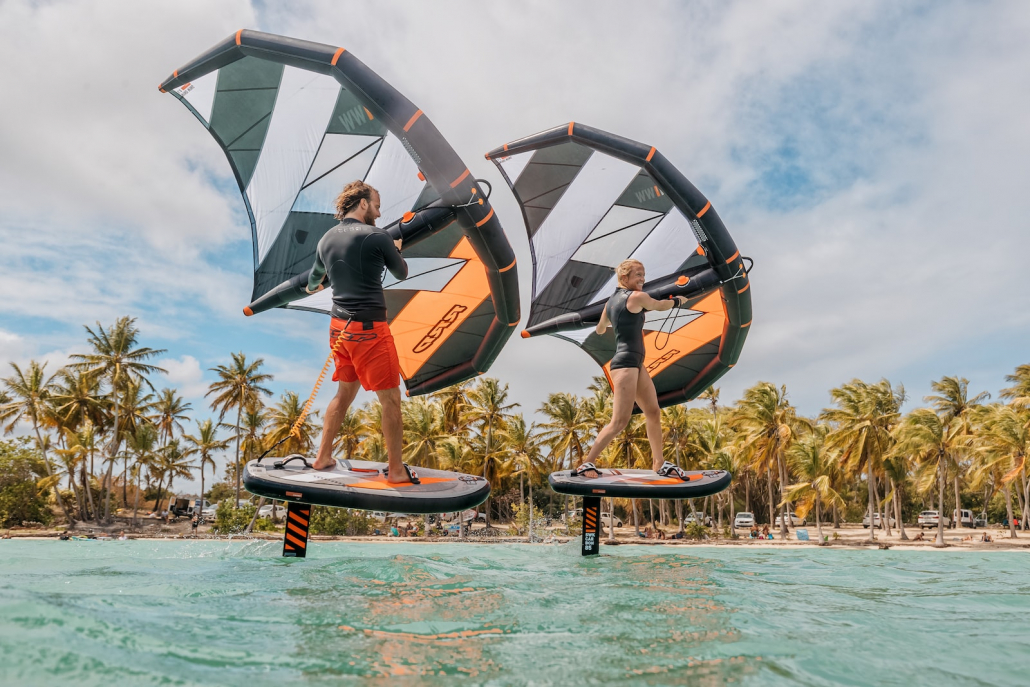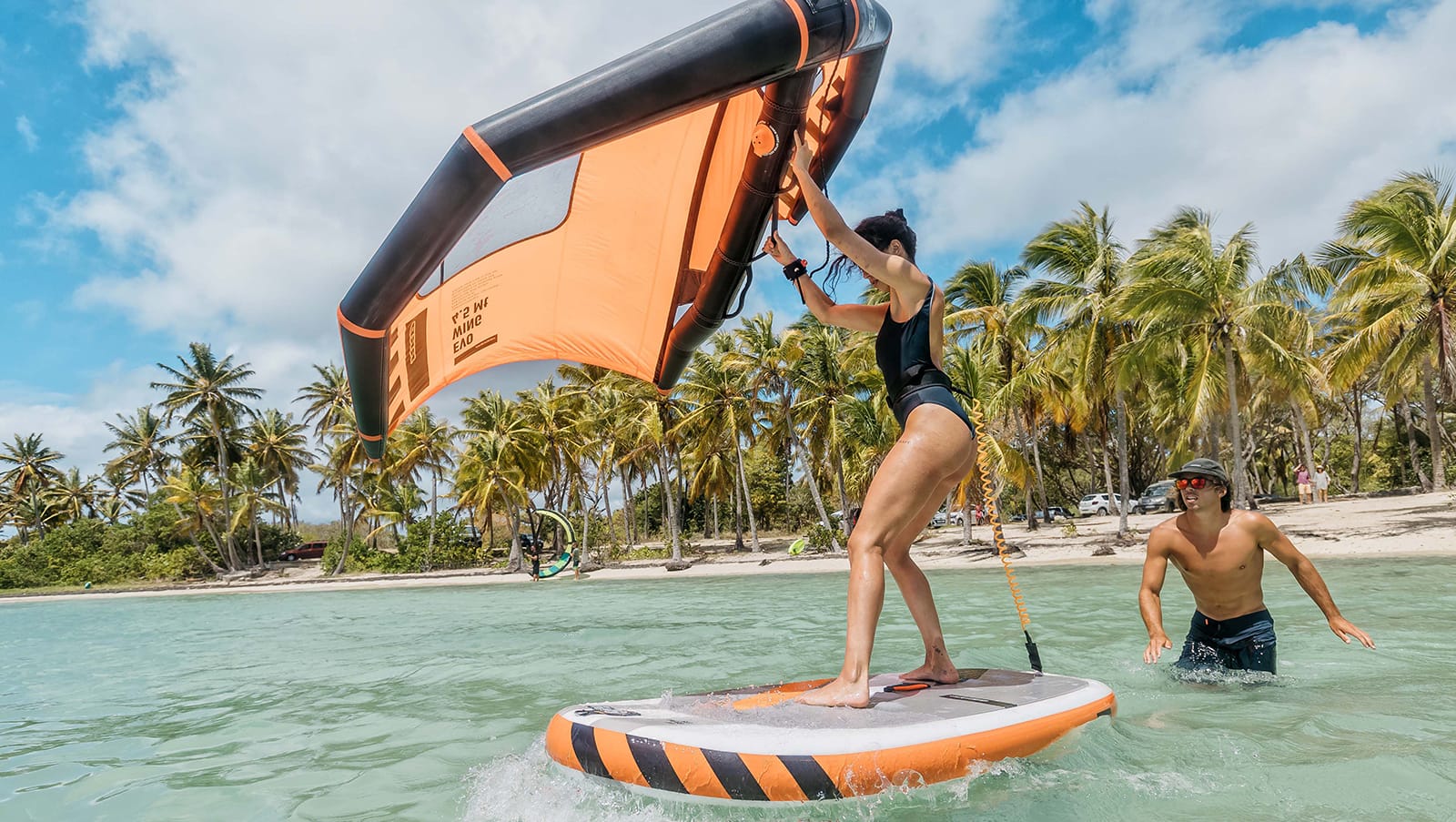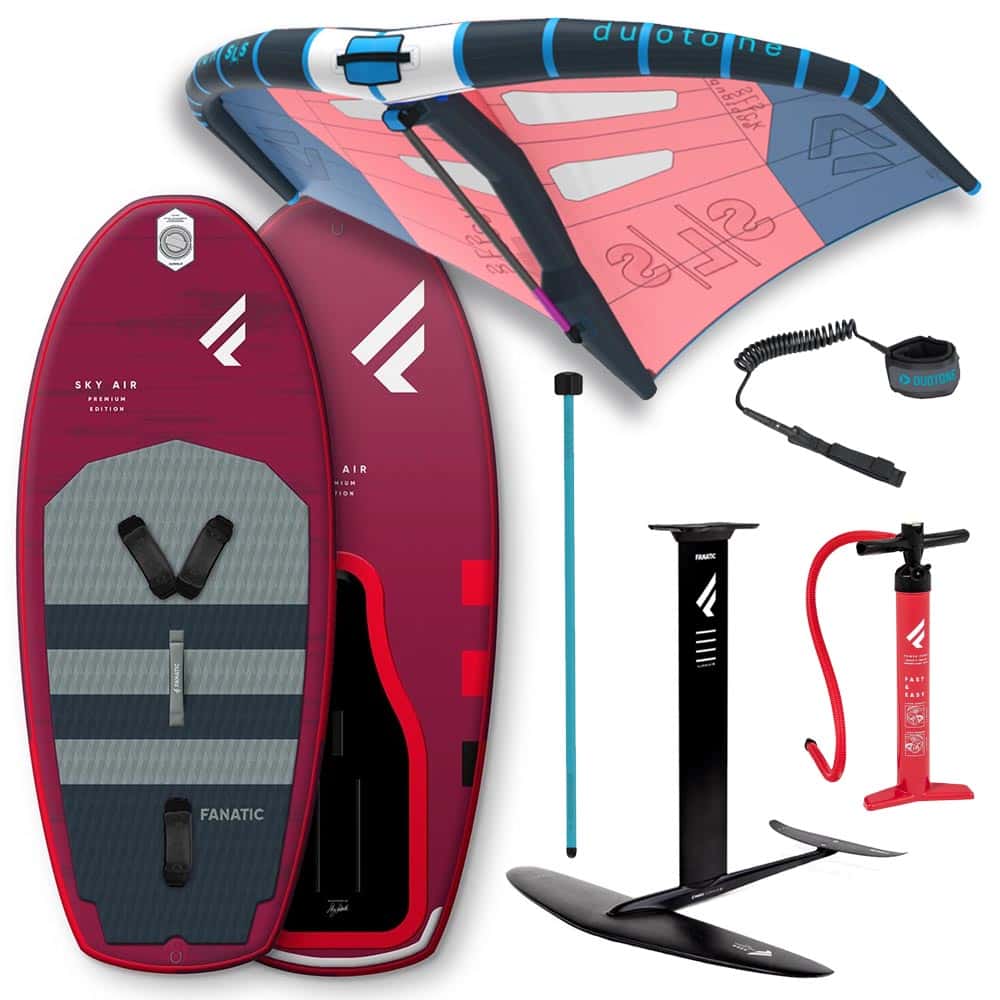What is Wingfoiling, How Does It Work, and How Much Does It Cost?
What is Wingfoiling?
Wingfoiling is a water sport that combines elements of windsurfing, kitesurfing, and stand-up paddleboarding. Participants use a surfboard with a hydrofoil (foil) underneath and a wing similar to a paraglider wing instead of a traditional sail.
The basic principle of Wingfoiling is to use the wing to capture the wind and generate propulsion, while the hydrofoil under the board reduces friction with the water, allowing the board to lift above the sea surface. This provides a flying sensation over the water, allowing practitioners to experience the pleasure of smooth and efficient gliding.
Wingfoiling has gained popularity in recent years due to its accessibility and versatility. It can be practiced in various wind conditions and different bodies of water such as oceans, lakes, and rivers. Additionally, it offers a unique sailing experience that combines the excitement of traditional water sports with the sensation of flight.

When Can Wingfoiling Be Practiced?
Usually, Wingfoiling takes place in moderate to strong wind conditions as wind is necessary to inflate and control the wing. While the exact conditions may vary based on the practitioner's skills and equipment used, here are some general considerations:
Wind: It is recommended to practice Wingfoiling on windy days with winds ranging from moderate to strong. The appropriate wind may depend on the size of the wing you are using and your skill level.
Location: Wingfoiling can be practiced in various locations, such as oceans, lakes, and rivers. It is essential to choose a place with sufficient space and no obstacles for maneuvering.
Water Conditions: Although Wingfoiling can be practiced in different water conditions, calm waters are often more suitable for beginners. However, some advanced practitioners may enjoy additional challenges in rougher waters.
Practitioner's Skill: Beginners may find it easier to learn in lighter wind conditions and calm waters, while more experienced practitioners may enjoy the excitement of stronger winds.
As always, it is crucial to follow safety recommendations and receive proper instruction, especially in the beginning. It is also essential to consider local regulations and adhere to the specific rules of each location to ensure safe and responsible Wingfoiling.
Is Wingfoiling Safer Than Kitesurfing, Windsurfing, and Other Water Sports?
The safety of any water sport, including Wingfoiling, depends on various factors such as the practitioner's skill, wind and water conditions, and the equipment used. In general, Wingfoiling shares some common risks with other water sports but also has specific features that can impact safety. Here are some considerations:
As with other water sports, safety in Wingfoiling is linked to the practitioner's skill. Proper training, supervision by qualified instructors, and the use of safety equipment are essential to minimize risks, especially for beginners.
The quality and correct maintenance of equipment are fundamental to ensuring safety. Good knowledge of equipment, including the wing, board, and hydrofoil, is crucial to avoid technical issues that could endanger the practitioner.
Wind and water conditions can influence safety. Practicing in extreme conditions or places with strong currents can increase risks. Practitioners should be aware of the conditions and adjust their approach accordingly.
In areas where multiple water sports are practiced, interaction with other water users (such as surfers, swimmers, etc.) must be considered to avoid collisions and ensure general safety.
Compared to kitesurfing and windsurfing, Wingfoiling might be perceived as more accessible to beginners due to its relative simplicity and less equipment. However, each sport has its safety considerations and associated risks. Safety should always be a priority, and practitioners should follow safety recommendations, receive proper instruction, and adhere to local regulations to minimize risks associated with Wingfoiling and other water sports.
Is a Course Necessary to Learn Wingfoiling?
While it is not strictly necessary to take a course to learn Wingfoiling, it is highly recommended to receive instruction from a qualified instructor, especially if you are a beginner. Here are several reasons why a course can be advantageous:
Safety: Wingfoiling involves handling specific equipment and navigating in water, which can pose risks. An instructor can teach you essential safety practices, such as handling equipment and reacting to potentially dangerous situations.
Faster Learning: Instruction from a professional can expedite your learning curve. Instructors are trained to teach effective techniques and provide real-time feedback, helping you acquire skills more quickly.
Equipment Choice and Adjustment: Instructors can help you choose the right equipment for your skill level and specific conditions. Additionally, they will teach you how to set up and adjust the equipment correctly, crucial for a successful and safe experience.
Knowledge of Conditions: Instructors often have in-depth knowledge of local conditions, such as currents, tides, and winds. This information is valuable for choosing the right time and place to practice Wingfoiling.
Avoiding Bad Habits: An instructor can help you avoid bad habits from the start, which can be challenging to correct later if self-taught.
If you choose not to take a course, it is important to research and acquire the necessary knowledge about safety, navigation techniques, and equipment choice before venturing into Wingfoiling. However, keep in mind that receiving instruction from a professional is often the safest and most effective option for learning this sport quickly and enjoyably.
In our school in Tarifa, we offer various course options for both beginners, with a beginner's Wingfoil course, where you will learn all the basics safely under the supervision of a qualified IWO instructor, and advanced Wingfoil courses, where you can continue to progress by learning maneuvers, transitions, jumps, and wave surfing.

How Much Does a Complete Wingfoil Setup Cost?
The cost of a complete Wingfoil setup can vary significantly based on the brand and quality of the equipment. Here is a general estimate of the main components needed for Wingfoiling and their possible price ranges (keep in mind that these prices may change over time and vary based on location):
Board with Hydrofoil (Foil): The price of the board and hydrofoil can vary widely. You can find Wingfoil boards with hydrofoils in a range from a few hundred euros to several thousand, depending on the brand, size, and material quality.
Wing: Wing prices also vary. You can find wings in a price range from around 300 euros to 1,000 euros or more, depending on size, brand, and wing specifications.
Mast and Fuselage: These are essential components of the hydrofoil, and like the board and wing, prices can vary. You can expect to pay from a few hundred to about a thousand euros or more for a mast and fuselage set.
Boom (Wing Handle): This component helps control the wing and also has a price range typically from about 90 euros to 300 euros or more, depending on construction. Not all foils have a boom, as many models have integrated and non-removable handles.
Harness: A Wingfoil harness can cost between 100 euros and 200 euros, depending on the brand and type. While not essential for beginners, it is recommended as your sailing level increases and during longer sessions to avoid back, scapular, and shoulder overloads.
In summary, the total cost of a complete Wingfoil setup could range from a few hundred euros to several thousand, depending on the quality and brand of the equipment you choose. In addition to these main components, you may also need to consider other accessories such as lines, screws, and transport cases, which can increase costs. As always, it is advisable to research and compare different options before making a purchase to ensure you get equipment that fits your needs and budget. In our online store Surf Kite Shop, you can find all the equipment you need to start as a beginner and advanced gear for those practicing Wingfoil at a higher level. You can find products from top brands like Duotone, Fanatic, and Rrd.

How Much Does a Wingfoil Course Cost?
The cost of a Wingfoil course can vary depending on the location, course duration, quality of instruction, and equipment provided. Below, I provide a general estimate, but keep in mind that these prices are approximate and may vary based on the region and the Wingfoil school:
An introductory course covering basic concepts and giving you a first experience in Wingfoiling might cost between 75 and 120 euros, depending on the duration and location. If you opt for a more comprehensive course that includes several days of instruction, with progressive lessons and water practice, you could be looking at a price range between 300 and 700 euros or more. Some courses may include equipment rental for the entire duration of the course. If you prefer personalized lessons and individualized attention, private lessons may have a higher cost. You can expect to pay around 60 euros per hour or more, depending on the instructor's experience.
These prices are general estimates and may vary based on the geographical location and the reputation of the Wingfoil school. Additionally, some courses may include equipment rental, while others may require you to bring or rent it separately.
Before committing to a course, it is advisable to research local schools, read reviews, and obtain detailed information on what is included in the cost. Safety and the quality of instruction are crucial, so choose a school that strikes a good balance between price and quality.
At What Age Can One Start Wingfoiling?
The right age to start Wingfoiling can vary based on the maturity, motor skills, and physical development of each individual. In general, Wingfoiling is accessible to people of different ages, but some factors should be considered:
The ability to learn and develop the necessary skills for Wingfoiling can vary among individuals. Some children or teenagers may have adequate motor skills and coordination to start Wingfoiling, while others may need more time to develop.
Previous experience in water sports, such as surfing, windsurfing, or kitesurfing, can facilitate learning Wingfoiling. However, it is not an absolute requirement, and many people start directly with Wingfoiling without prior experience in water sports.
Children and teenagers wanting to practice Wingfoiling should receive proper supervision and preferably instructions from experienced professionals. Safety is a key consideration, and it is essential for young practitioners to be guided by qualified instructors.
The weight of the practitioner can be a significant factor in choosing Wingfoil equipment. Some gear is designed to support specific weights, and younger children may need equipment and wings more suitable for their size and weight.
Before a child or teenager starts Wingfoiling, it is advisable to consult qualified instructors and follow safety guidelines established by Wingfoil schools. Adult supervision and choosing safe and controlled water conditions are also essential to ensure a positive and safe learning experience.
For adults, there is no age limit, so dare to contact us to book your course!
Why Is Wingfoiling So Popular Now?
The popularity of Wingfoiling has grown significantly in recent years for several reasons:
Accessibility: Wingfoiling is considered more accessible than some traditional water sports such as windsurfing or kitesurfing. It can be learned more quickly, and the necessary equipment is more compact and easy to transport.
Versatility: Wingfoiling is versatile and can be practiced in a variety of wind conditions and water types. You can enjoy it in oceans, lakes, rivers, and other bodies of water, making it appealing to a broader audience.
Flying Sensation: The experience of "flying" over the water using Wingfoiling is unique and thrilling. It offers a sense of freedom and lightness that attracts many practitioners seeking new experiences.
Community: The Wingfoiling community has grown, with more enthusiasts sharing their experiences, tips, and tricks online and on-site. This growing community has helped spread the popularity of Wingfoiling.
Water Sport Trends: Trends in water sports change over time, and Wingfoiling has caught the attention of those looking for something new and exciting. Spectacular images and videos of Wingfoil practitioners have contributed to creating growing interest in this sport.
Overall, Wingfoiling has earned a special place among water sports enthusiasts due to its combination of accessibility, versatility, and excitement. If you are interested in trying Wingfoiling, make sure to do it safely under the guidance of qualified instructors and in accordance with safety recommendations. It is a unique experience that could become your new passion!

